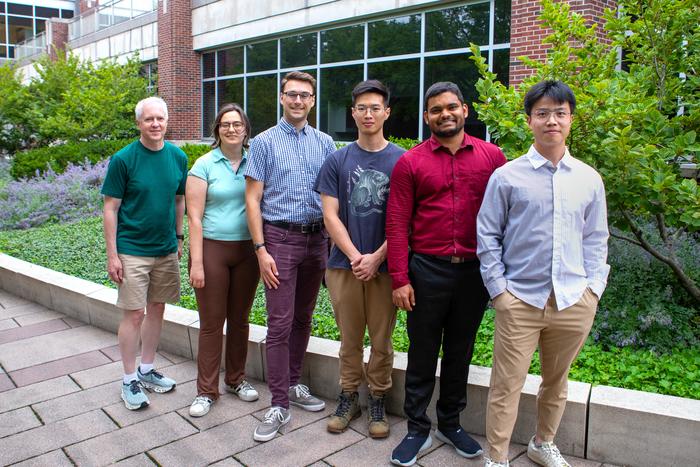In a groundbreaking advancement poised to revolutionize the field of medical diagnostics, researchers at the Carl R. Woese Institute for Genomic Biology, University of Illinois Urbana-Champaign, have engineered innovative photonic crystal-based biosensors with unprecedented sensitivity and functionality. Building upon nature’s own ingenious designs, this team has synthesized nanostructured materials that leverage the intricate interplay between light and matter at the nanoscale. Their pioneering work ushers in a new era of point-of-care diagnostic technologies, offering rapid, cost-effective, and highly sensitive detection of disease biomarkers that could dramatically improve early diagnosis and patient outcomes worldwide.
Traditional diagnostic assays often rely on the collection and transportation of clinical samples to centralized laboratories, processes that are time-consuming, expensive, and logistically challenging. This delay impedes timely treatment interventions, particularly in underserved regions. Recognizing this critical bottleneck, the research led by Professor Brian Cunningham focuses on transformational biosensor designs that operate efficiently at the site of care. Central to these advancements is the deployment of photonic crystals—nano-engineered materials capable of manipulating light through their precisely patterned structures, inspired by biological photonic architectures such as those found in peacock feathers.
Peacock feathers are a marvel of natural nanotechnology; their brilliant iridescent colors arise not from pigments but from the interaction of light waves within intricate, periodic photonic crystal nanostructures on the feather surface. Emulating this mechanism, scientists have developed synthetic photonic crystals that can be tailored for specific optical properties, facilitating enhanced light absorption and emission critical for biosensing applications. This biomimetic strategy unlocks new potentials in the detection of biological molecules by harnessing controlled optical resonance effects.
.adsslot_3iGRxjkTA2{ width:728px !important; height:90px !important; }
@media (max-width:1199px) { .adsslot_3iGRxjkTA2{ width:468px !important; height:60px !important; } }
@media (max-width:767px) { .adsslot_3iGRxjkTA2{ width:320px !important; height:50px !important; } }
ADVERTISEMENT
The Nanosensors Group at the University of Illinois Urbana-Champaign has taken these bio-inspired concepts a step further by integrating gold nanoparticles into their photonic crystal systems. Historically, gold nanoparticles are renowned for their plasmonic properties, which can amplify fluorescence signals from labeled biomarkers, thereby enhancing detection sensitivity. However, a persistent challenge has been the phenomenon of fluorescence quenching, where nanoparticles, particularly at close proximity, paradoxically suppress the very signals they intend to enhance. This quenching creates a “dead zone” close to the nanoparticle surface, constraining sensor performance and sensitivity.
In their recent publication in MRS Bulletin, the team reveals that coupling these cryosoret nanoassemblies with specialized photonic crystal substrates results in an extraordinary 200-fold enhancement of fluorescence signals compared to photonic crystals alone. This dramatic improvement underscores the effectiveness of engineered nanostructures in overcoming fluorescence dead zones, positioning this technology as a powerful platform for detecting extremely low concentrations of pathogenic biomarkers—a critical capability for early disease diagnosis.
Not resting on these accomplishments, the researchers have pushed the envelope by incorporating magnetic tunability into their nanoassemblies, crafting what they term magneto-plasmonic cryosoret nanoassemblies. This hybrid system is engineered to harness both the electric and magnetic components of the electromagnetic spectrum—an innovation rarely exploited in biosensing. Light comprises oscillating electric and magnetic fields, yet most sensing platforms primarily utilize only the electric aspect. Integrating magnetic responsiveness introduces new dimensions of control and functionality, facilitating dynamic tuning and enhanced interaction with biological targets.
Published recently in APL Materials, this magneto-plasmonic platform marvelously couples with photonic crystals to produce ultra-sensitive fluorescence detection in the attomolar range, even while minimizing quenching effects. The dual-mode interaction amplifies light-matter coupling with remarkable precision, opening avenues for finely tunable sensing environments and multi-modal detection strategies. Such capabilities herald the next generation of biosensors that can be actively controlled and optimized for varied biomedical applications, ranging from early cancer detection to monitoring infectious diseases.
Professor Cunningham emphasizes that this research transcends traditional photonic or plasmonic methods by creating a hybrid optical system where photons are meticulously manipulated rather than passively emitted. This synergy across photonic crystal engineering, plasmonic nanoassembly design, and chemical functionalization exemplifies the interdisciplinary approach needed to tackle challenges in modern medical diagnostics. The convergence of these advanced technologies lays a robust foundation for portable, point-of-care devices that combine sensitivity, specificity, and adaptability.
Looking ahead, the research team aims to refine these nanoassemblies to selectively bind clinically relevant biomarkers such as microRNAs, circulating tumor DNA, and viral particles. These molecular targets are crucial in oncology and infectious disease management, where early and precise detection can markedly influence treatment success. The ultimate vision is to transition from laboratory prototypes to deployable biosensors that integrate seamlessly into clinical workflows, democratizing access to advanced diagnostics worldwide.
This extraordinary research has been supported by leading institutions including the National Institutes of Health, the National Science Foundation, and the Cancer Center at Illinois, reflecting strong recognition of its potential impact. As the field of biosensing moves toward highly customizable, smart materials inspired by nature and refined by nanotechnology, these findings represent a milestone in the quest for rapid, sensitive, and accessible diagnostic tools.
In summary, the interplay of photonic crystals with cryosoret and magneto-plasmonic nanoassemblies inaugurates a transformative chapter in biosensor technology. By overcoming fundamental fluorescence quenching limitations and exploiting both electromagnetic components of light, the researchers have devised a versatile and powerful platform with broad implications for medical diagnostics and beyond. The horizon of point-of-care testing is expanding rapidly, empowered by these elegant nanotechnological innovations inspired by the intricate brilliance of nature itself.
Subject of Research: Photonic crystal-enhanced fluorescence biosensors utilizing gold cryosoret nanoassemblies and magneto-plasmonic nano-assemblies for ultra-sensitive biomarker detection
Article Title: Photonic crystal band edge coupled enhanced fluorescence from magneto-plasmonic cryosoret nano-assemblies for ultra-sensitive detection
News Publication Date: 1-Apr-2025
Web References:
https://doi.org/10.1063/5.0251312
Image Credits: Isaac Mitchell
Keywords: Photonic crystals, biosensors, fluorescence enhancement, gold nanoparticles, cryosoret nanoassemblies, magneto-plasmonic materials, fluorescence quenching, point-of-care diagnostics, nanotechnology, light-matter interaction, biomarker detection, medical diagnostics
Tags: advanced medical diagnosticscost-effective medical diagnosticsdisease biomarker detectionearly disease diagnosis innovationsinnovative biosensor designsnanoscale light manipulationnanostructured materials in healthcarephotonic crystal biosensorspoint-of-care testing technologiesrapid diagnostic solutionssensitivity in biosensingtransformative healthcare technologies





